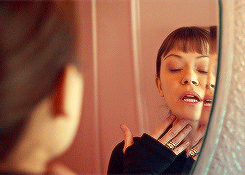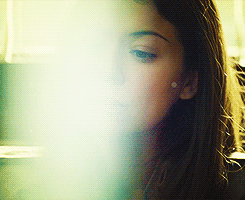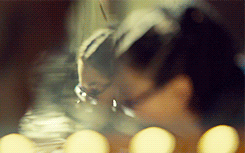In Orphan Black, mirrors make for a pretty obviously symbolic motif. Mirrors, by nature, reflect what you are back at you, so it makes perfect sense for them to be heavily at play in a show like this.
Throughout the series' first episode, “Natural Selection,” mirrors seem to follow Sarah Manning as she becomes submerged in the world of her double. We constantly see Sarah through mirrors, from the very first moment she begins to question herself, and all throughout her transformation into Beth.



But, the mirrors don't stop there. Often associated with twins and diametric opposites (thesis and antithesis, yin and yang, right and left), mirrors serve the story of Orphan Black in plenty of symbolic ways.
And their presence, obviously, isn't just meant to be seen and not heard.
In the scene in "Instinct" (Season 1, Episode 2) when Sarah is burying Katja's body in the woods, we hear a voice from Sarah's "funeral" quote the following song lyrics:
We're in bummed out cityWell, Rockabilly Bob, Sarah's life certainly seems to be. As Sarah stares into the face of the second twin of herself she's seen die, it's clear that the reflections are starting to be more than mere coincidence.
I plead your mercy and your pity
Is not life a mirror maze?
In addition, as traditional symbols of femininity, consciousness, and deception, the symbolism of the mirror also helps to visually underline the importance of these themes throughout the show. For example, mirrors are at play when Sarah first meets Katja:

When Sarah talks with Cosima at the bar:

When Cosima encounters Delphine:

When we Rachel meet for the first time:

And even when we get our first, bloody introduction to Helena:

But, interestingly, with regard to Helena, despite being in front of a mirror when she appears in this opening scene of "Effects of External Conditions," the viewer never sees her reflection. Helena believes she is the original, and, therefore, doesn't align with what the mirrors symbolize in Orphan Black; a reflected and repeated identity is not something she has been taught to accept or confront. Instead, the extremity of Helena's abuse has fragmented her identity so severely that she doesn't have a reflection for the same reason Dracula doesn't have a reflection: there's no soul to see--at least not at this point.
Helena's fragmentation, however, is internal. The cinematography comes into play when the aperture of the camera lens is constantly changing to make her life appear as a jarring haze of different focus points; accompanied by the stress-inducing, high-pitched screech of her theme song, we can infer that these elements portray the jagged pieces of her broken mind.
 |
| via |
Fragmentation occurs in the cinematography of the other clones occurs as well, just in a slightly different way. In many cases, the image of each clone begins to partially split, as if the characters are being physically split in two.
We see this several times, with Alison:
 |
| via |
 |
| via |
 |
| via |
At critical points in the narrative, however, identity is not only visually fragmented, it gets totally shattered.

In this final scene of Orphan Black's first episode, half of Sarah's face is taken up by the windshield's shattered glass. And, really, is there a better time to insert this imagery than when Sarah's life is officially thrown into the dangerous world of Clone Club? Not really.
But, just in case we forgot that we really have officially entered Orphan Black's mirror maze, it's good to remember that when Katja's hotel room gets trashed by Helena, it's not just the sink that gets broken, it's the mirror too.
Whether a mirror reflects, refracts, or distorts each clone's image underlines the internal struggle for identity so prevalent in the themes of Orphan Black. When we look in the mirror to find our reflection looking back at us, there is an intrinsic disconnect between the image we perceive and the self we experience. When we finally realize that we are not that reflection, it reinforces our sense of self. But, it's only through the encounter with the mirror that such a realization can occur.

Samantha is a mirror image twin and a proud lefty. Her love for delving into the fictional world is balanced for a passion for hiking and biking.
Follow Samantha on


This is lovely
ReplyThis is the nice post and answer to my question that i was finding for a long time. I will test your services.
Reply